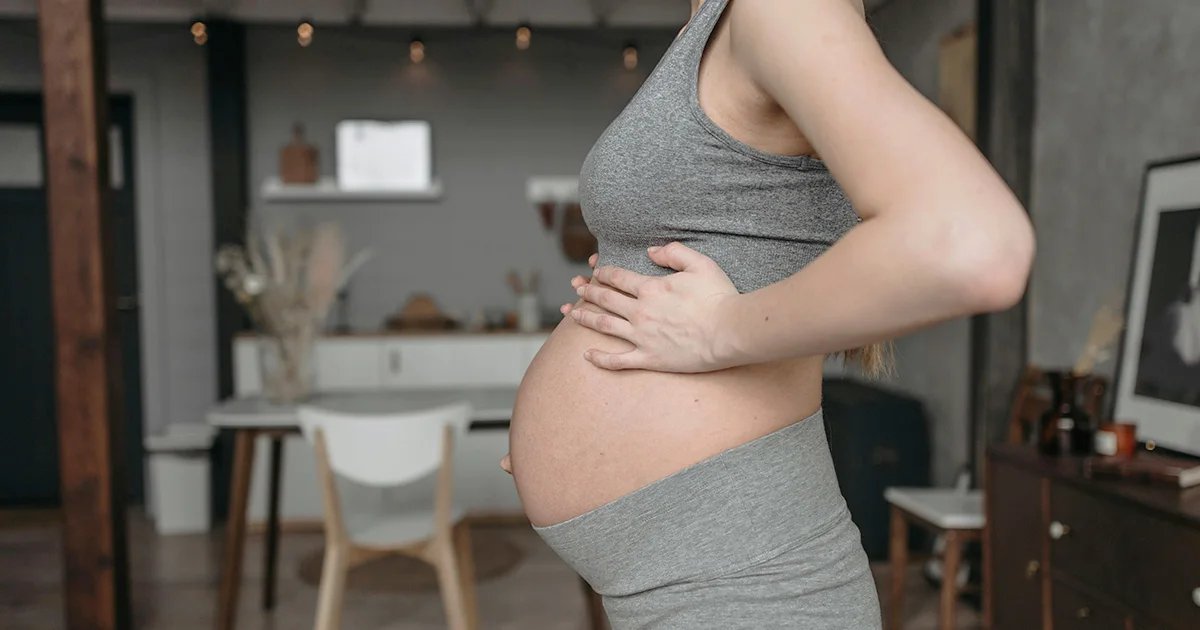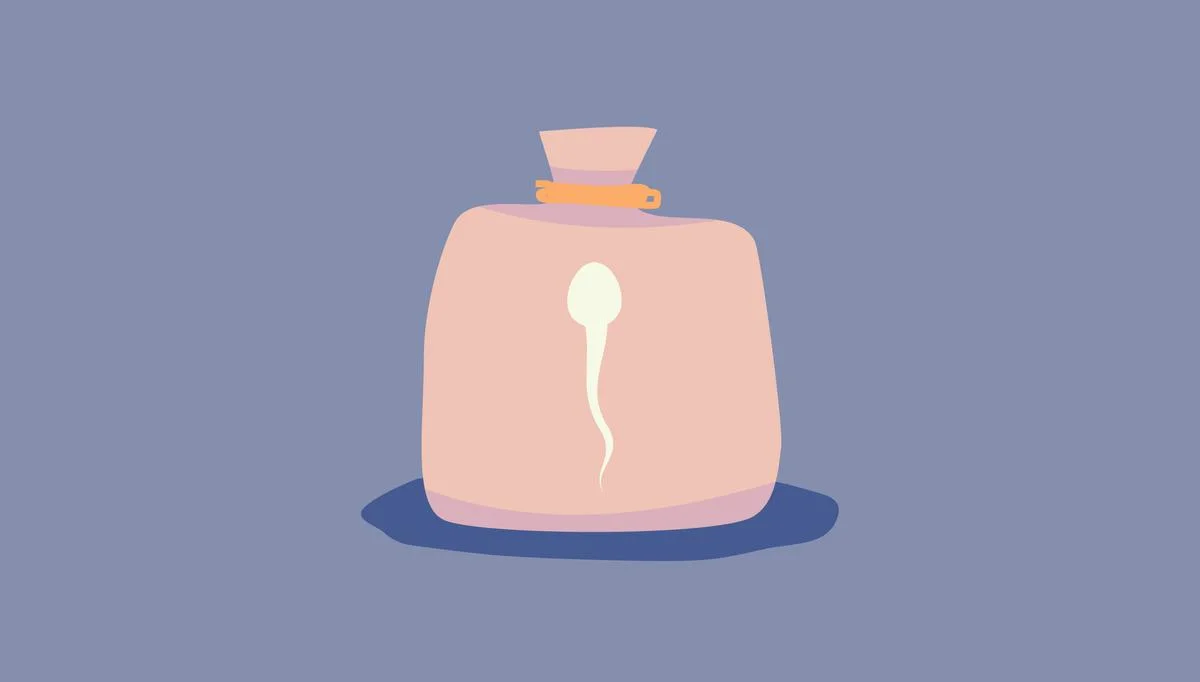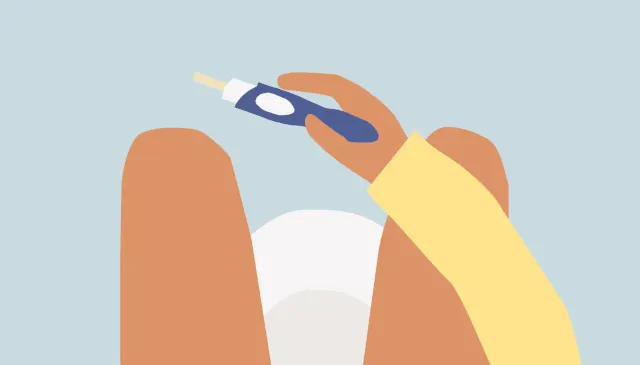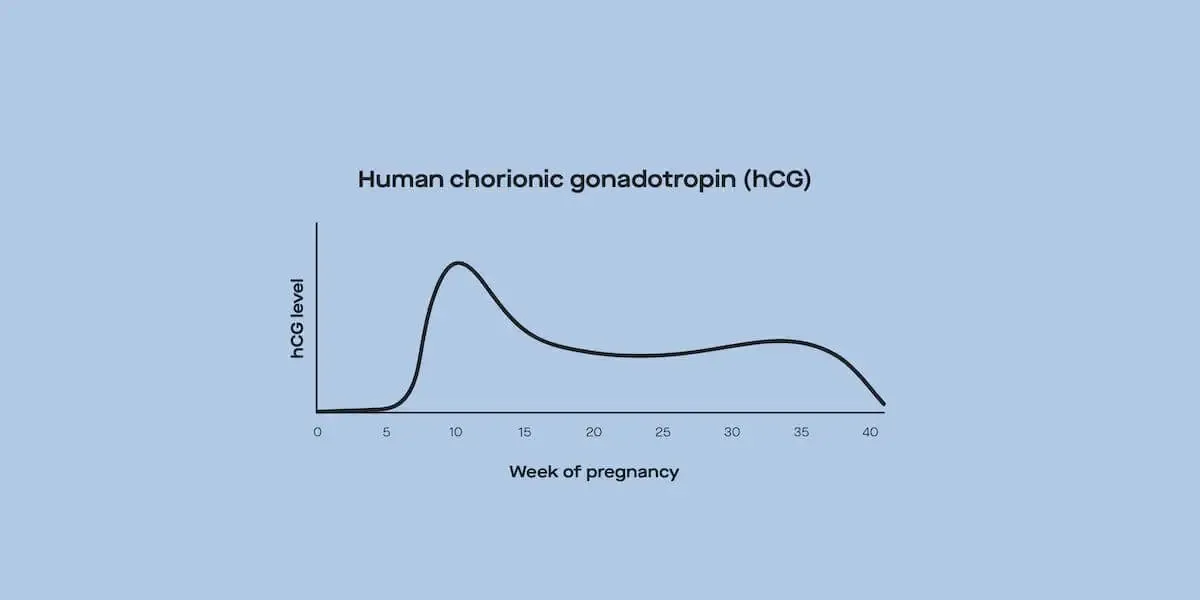Here's what we'll cover
Here's what we'll cover
Having trouble getting pregnant is more common than you might think. About 12% of couples in the United States have difficulty getting pregnant (Van Heertum, 2017). If you want to get pregnant but haven’t yet succeeded—or if you’d like to conceive sooner rather than later—read on for helpful tips and information. You might be surprised to find out what actually helps and what doesn’t matter at all—like lying down after sex and the type of lube you use.
9 ways to increase chances of pregnancy
There are many myths out there about strategies you should use to make you more likely to conceive. Most of those old wives’ tales are just that. But there are some things that are proven to improve fertility.
1. Schedule sex
One of the best ways to boost your chances of getting pregnant is to schedule sex for the times when you’re most fertile (Manders, 2015). As a woman, you have a “window of fertility” each month—the five days before you ovulate and the day of ovulation. That’s because a woman's egg is fertile for only about 12–24 hours after it’s released, but a man’s sperm can live in the uterus for up to five days. During the fertility window, you should have sex every day or every other day for the best chances of becoming pregnant.
To schedule sex, you need to chart your menstrual cycle, either on paper or with an app. Many fertility-tracking websites and apps are out there, but many can be wildly inaccurate (Setton, 2016). The best idea is to track your fertility signs at home (mainly your basal body temperature, cervical mucus, and cervical position). Doing so can also help reveal some possible fertility problems. Keep track of your cycle on a calendar. Women with regular menstrual cycles generally ovulate about two weeks before their periods.
If your menstrual cycles are irregular, it’s especially important to know when you ovulate. You can track fertility signs, like waking temperature. You can also use an ovulation test kit, which detects a rise in luteinizing hormone (LH) in the urine (a rise in LH signals the ovary to release the egg). When you ovulate may vary each month if your cycles are irregular, so keeping track of these signs can help you better time your fertility window.
2. Use the lube you prefer
Some lubes are formulated to be “fertility-friendly” with ingredients that are non-toxic to sperm and may even support sperm health. These do work—at least in a test tube. However, in real life, a study of almost 6,500 women found that the type of commercially available lubricant (water-based, including fertility-friendly; oil-based; or silicone-based) the women used did not affect how long it took them to conceive (McInerney, 2018). So feel free to use whatever lube you like (except, of course, lubes that contain spermicide, as that will certainly decrease the odds of getting pregnant).
3. Limit caffeine
The evidence is mixed on how caffeine affects fertility. One large-scale study found there is little, if any, relationship between caffeine intake and getting pregnant, but found that three or more cups of coffee (300mg caffeine) a day increases the risk of miscarriage (Lyngsø, 2017). A more recent review went a step further and suggested that caffeine should be avoided altogether by both pregnant women and women who want to become pregnant (James, 2021).
If you do decide to keep drinking coffee and other caffeinated beverages while you’re trying to get pregnant, the American College of Obstetricians and Gynecologists (ACOG) advises women to limit caffeine consumption to less than 200 mg per day (about 12 ounces of coffee), both while pregnant and while trying to get pregnant (ACOG, 2010).
4. Maintain a healthy weight
Carrying excess weight or too little weight can both impact your fertility.
A body mass index (BMI) greater than 27 lowers fertility and can harm the workings of hormones involved in reproduction. That’s because fat tissue isn’t inactive. It acts as an endocrine (hormone-secreting) organ and releases adipokines, chemicals that affect your menstrual cycle, egg implantation in the uterine lining, and many other aspects of reproduction (Silvestris, 2018).
Having obesity (a BMI over 30) can cause additional complications, such as problems getting pregnant, increased miscarriage rate, and worse outcomes in assisted reproduction technology treatments. If you have obesity and have experienced symptoms of infertility, weight loss through lifestyle changes can restore regular menstrual cycles and ovulation, increasing the chances of conception (Silvestris, 2018). A loss of about 10% of total body weight is believed to restore regular ovulation in 50–100% of women in less than a year (Walker, 2021).
Conversely, being underweight (BMI less than 17) or having an eating disorder can also cause infertility. In this situation, putting on pounds to attain a healthy body weight can help the ovaries to function normally. In addition, gonadotropins—mainly follicle-stimulating hormone (FSH) and luteinizing hormones (LH)—can be given to induce ovulation (Walker, 2021).
5. If you smoke, quit
Smoking when you’re trying to conceive is a very bad idea for both men and women. In addition to its terrible effects on your own personal health, smoking reduces the chances of conception, harms both eggs and sperm, and damages DNA (Wesselink, 2019; Kovac, 2015). Talk to your healthcare provider about effective quitting plans and aids.
6. Limit how much alcohol you drink
Drinking fewer than 14 servings of alcohol per week (two per day) seems not to affect women’s fertility, but heavier drinking decreases fertility (Mikkelsen, 2016). However, drinking any amount of alcohol when you’re pregnant (especially early in pregnancy) can harm embryos and fetuses, causing congenital disabilities and developmental problems such as fetal alcohol syndrome. Damaging effects on the fetus may begin as early as immediately after the egg is implanted—a time when you may not know yet that you’re pregnant—so it’s generally a good idea to stay away from alcohol while trying to get pregnant (Van Heertum, 2017). Drinking alcohol while you’re pregnant also increases the rate of miscarriages and decreases the chances of a live birth.
If you do decide to drink while you’re trying to get pregnant, do so only outside of your window of fertility. Don’t drink alcohol unless you’re absolutely sure you’re not pregnant.
7. Don’t worry about the position
You don’t hurt your chances of getting pregnant by having sex in positions where your male partner can penetrate deeply, like missionary position and doggie-style (from behind). But it probably doesn’t help a great deal, either. Sperm are excellent swimmers, and it takes them only a few minutes after ejaculation to reach the cervix and enter the uterus, no matter what position you’ve had sex in.
8. Lie down after sex
Lying down after sex instead of getting up and heading for the bathroom will help you retain the semen in your vagina. Some people think that putting your legs up in the air helps get the semen moving in the right direction. This may be folklore, but it’s certainly not going to lower your chances of conceiving. “Conception cups”—soft, bell-shaped silicone cups inserted into the uterus after sex—keep more semen in contact with the cervix. It’s possible this could increase your chances of conception, but there is currently little research behind these devices.
9. Reduce stress
High levels of stress can lower fertility in women (Palomba, 2018). So if you’re stressed, take steps to relax. Meditate, do gentle exercise or yoga, take time for activities you enjoy—do whatever works to help you relax.
If you’re over 35 or 40 years old
The single most important factor in your fertility is your age. Women are most fertile in their early 20s. Fertility declines after that and starts to drop steeply after age 35. The older you get, the lower the quantity and quality of your eggs (Vollenhoven, 2018). Women older than 35 years of age have an increased risk of infertility, miscarriage, and congenital abnormalities (Liu, 2015).
But that doesn’t mean you can’t, or shouldn’t, have a baby after age 35! In fact, in the last 40 years, there’s been a dramatic rise in the number of women having babies at age 35 and older. In 2018, almost a fifth of women giving birth in the U.S. were 35 or older, up from 15% in 2013, 11% in 2002, and 8% in 1990 (Martin, 2019). In the United Kingdom, since 2016, every age group except for women over age 40 has had decreases in fertility rates (Corps, 2020). And the majority of over-35 women who stay pregnant to term have healthy babies.
In general, it tends to take women over age 35 longer to get pregnant than younger women. You can boost your chances of getting pregnant by living a healthy and active lifestyle, eating whole foods (instead of processed foods and fast food), including lots of fresh vegetables and fruits, and following the tips above. You can also take a supplement containing myo-inositol, which studies have found to improve egg quality and fertilization rates (Zheng, 2017).
If you’re over age 35 or 40 and are having difficulty getting pregnant, see your healthcare provider. There are many different types of assisted reproductive technology (ART) that can help you conceive.
If you have polycystic ovarian syndrome (PCOS)
The single most common hormonal disorder in reproductive-aged women is polycystic ovarian syndrome (PCOS). It’s estimated that about 3–10% of women in the U.S. have it, and it’s one of the leading causes of infertility. In PCOS, the sex hormones are imbalanced. Along with infertility, its symptoms can include having irregular menstrual cycles, multiple small cysts in the ovaries, and type 2 diabetes (Wolf, 2018).
PCOS is strongly linked with having excess body fat. If you have PCOS, excess body weight, and trouble getting pregnant, it can help to lose weight and exercise (Sawant, 2019). And good news on that myo-inositol supplement we mentioned above—it may also help with PCOS-related infertility (Zheng, 2017).
There are a number of medical options for treating PCOS-related infertility. Certain medications can induce ovulation and regulate insulin levels (Sawant, 2019). Speak with your healthcare provider to discuss options that would be most appropriate for you.
If you have endometriosis
Endometriosis is another common condition. It’s estimated that about 5% of American women have it. One study found that it caused 15% of infertility cases (Walker, 2021).
In endometriosis, tissue that is usually found only in the uterus grows in other parts of the body, such as the cervix or the fallopian tubes. Even mild endometriosis can lower your chances of becoming pregnant. Treatment for endometriosis may involve suppressing the growth of the abnormal tissue, removing it surgically, or stimulating ovulation and the growth of the follicles. These treatments are often combined with ART (Tanbo, 2017).
How long should you wait before seeing a healthcare provider?
The American Society of Reproductive Medicine (ASRM) recommends that, for women younger than 35 years old, couples should be evaluated for infertility if they don’t achieve pregnancy within 12 months of trying by having unprotected intercourse or donor insemination. For women older than 35, couples should be evaluated within 6 months (Walker, 2021).
DISCLAIMER
If you have any medical questions or concerns, please talk to your healthcare provider. The articles on Health Guide are underpinned by peer-reviewed research and information drawn from medical societies and governmental agencies. However, they are not a substitute for professional medical advice, diagnosis, or treatment.
ACOG Committee Opinion No. 462: Moderate caffeine consumption during pregnancy. (2010). Obstetrics and Gynecology, 116 (2 Pt 1), 467–468. doi: 10.1097/AOG.0b013e3181eeb2a1. Retrieved from https://pubmed.ncbi.nlm.nih.gov/20664420/
Corps, D. (2020). Births in England and Wales: 2019. Births in England and Wales—Office for National Statistics . Retrieved on Dec. 27, 2021 from https://www.ons.gov.uk/peoplepopulationandcommunity/birthsdeathsandmarriages/livebirths/bulletins/birthsummarytablesenglandandwales/2019
Filip, L., Duică, F., Prădatu, A., Crețoiu, D., Suciu, N., Crețoiu, S. M., et al. (2020). Endometriosis associated infertility: A critical review and analysis on etiopathogenesis and therapeutic approaches. Medicina , 56 (9), 460. doi: 10.3390/medicina56090460. Retrieved from https://pubmed.ncbi.nlm.nih.gov/32916976/
James J. E. (2021). Maternal caffeine consumption and pregnancy outcomes: A narrative review with implications for advice to mothers and mothers-to-be. BMJ Evidence-Based Medicine , 26 (3), 114–115. doi: 10.1136/bmjebm-2020-111432. Retrieved from https://pubmed.ncbi.nlm.nih.gov/32843532/
Kovac, J. R., Khanna, A., & Lipshultz, L. I. (2015). The effects of cigarette smoking on male fertility. Postgraduate Medicine , 127 (3), 338–341. doi: 10.1080/00325481.2015.1015928. Retrieved from https://www.ncbi.nlm.nih.gov/pmc/articles/PMC4639396/
Liu X. J. (2016). Targeting oocyte maturation to improve fertility in older women. Cell and Tissue Research , 363 (1), 57–68. doi: 10.1007/s00441-015-2264-y. Retrieved from https://pubmed.ncbi.nlm.nih.gov/26329301/
Lyngsø, J., Ramlau-Hansen, C. H., Bay, B., Ingerslev, H. J., Hulman, A., & Kesmodel, U. S. (2017). Association between coffee or caffeine consumption and fecundity and fertility: A systematic review and dose-response meta-analysis. Clinical Epidemiology , 9 , 699–719. doi: 10.2147/CLEP.S146496. Retrieved from https://www.ncbi.nlm.nih.gov/pmc/articles/PMC5733907/
Manders, M., McLindon, L., Schulze, B., Beckmann, M. M., Kremer, J. A., & Farquhar, C. (2015). Timed intercourse for couples trying to conceive. The Cochrane Database of Systematic Reviews , (3), CD011345. doi: 10.1002/14651858.CD011345.pub2. Retrieved from https://pubmed.ncbi.nlm.nih.gov/25775926/
Martin, J. A., Hamilton, B. E., Osterman, M., & Driscoll, A. K. (2019). Births: Final data for 2018. National vital statistics reports: from the Centers for Disease Control and Prevention, National Center for Health Statistics, National Vital Statistics System , 68 (13), 1–47. Retrieved from https://pubmed.ncbi.nlm.nih.gov/32501202/
McInerney, K. A., Hahn, K. A., Hatch, E. E., Mikkelsen, E. M., Steiner, A. Z., Rothman, K. J., et al. (2018). Lubricant use during intercourse and time to pregnancy: A prospective cohort study. BJOG: An International Journal of Obstetrics and Gynaecology, 125 (12), 1541–1548. doi: 10.1111/1471-0528.15218. Retrieved from https://www.ncbi.nlm.nih.gov/pmc/articles/PMC6139089/
Mikkelsen, E. M., Riis, A. H., Wise, L. A., Hatch, E. E., Rothman, K. J., Cueto, H. T., & Sørensen, H. T. (2016). Alcohol consumption and fecundability: prospective Danish cohort study. BMJ (Clinical Research Ed.) , 354 , i4262. doi: 10.1136/bmj.i4262. Retrieved from https://pubmed.ncbi.nlm.nih.gov/27581754/
Palomba, S., Daolio, J., Romeo, S., Battaglia, F. A., Marci, R., & La Sala, G. B. (2018). Lifestyle and fertility: the influence of stress and quality of life on female fertility. Reproductive Biology and Endocrinology , 16 (1), 113. doi: 10.1186/s12958-018-0434-y. Retrieved from https://pubmed.ncbi.nlm.nih.gov/30501641/
Reis, F. (2019). Faculty opinions recommendation of recommendations from the international evidence-based guideline for the assessment and management of polycystic ovary syndrome. Faculty Opinions—Post-Publication Peer Review of the Biomedical Literature . doi: 10.3410/f.733703264.793559338. Retrieved from https://pubmed.ncbi.nlm.nih.gov/32916976/
Sawant, S., & Bhide, P. (2019). Fertility treatment options for women with polycystic ovary syndrome. Clinical Medicine Insights. Reproductive Health , 13 , 1179558119890867. doi: 10.1177/1179558119890867. Retrieved from https://pubmed.ncbi.nlm.nih.gov/31908561/
Setton, R., Tierney, C., & Tsai, T. (2016). The accuracy of web sites and cellular phone applications in predicting the fertile window. Obstetrics and Gynecology , 128 (1), 58–63. doi: 10.1097/AOG.0000000000001341. Retrieved from https://pubmed.ncbi.nlm.nih.gov/27275788/
Silvestris, E., de Pergola, G., Rosania, R., & Loverro, G. (2018). Obesity as disruptor of the female fertility. Reproductive Biology and Endocrinology, 16 (1), 22. doi: 10.1186/s12958-018-0336-z. Retrieved from https://pubmed.ncbi.nlm.nih.gov/29523133/
Tanbo, T., & Fedorcsak, P. (2017). Endometriosis-associated infertility: Aspects of pathophysiological mechanisms and treatment options. Acta Obstetricia et Gynecologica Scandinavica , 96 (6), 659–667. doi: 10.1111/aogs.13082. Retrieved from https://pubmed.ncbi.nlm.nih.gov/27998009/
Van Heertum, K., & Rossi, B. (2017). Alcohol and fertility: how much is too much? Fertility Research and Practice, 3 (10). doi: 10.1186/s40738-017-0037-x. Retrieved from https://www.ncbi.nlm.nih.gov/pmc/articles/PMC5504800/
Vollenhoven, B., & Hunt, S. (2018). Ovarian ageing and the impact on female fertility. F1000Research , 7 , F1000 Faculty Rev-1835. doi: 10.12688/f1000research.16509.1. Retrieved from https://pubmed.ncbi.nlm.nih.gov/30542611/
Walker, M. H., & Tobler, K. J. (2021). Female infertility. [Updated 2021 Jan 1]. In: StatPearls [Internet]. Retrieved on Dec. 20, 2021 from https://www.ncbi.nlm.nih.gov/books/NBK556033/
Wesselink, A. K., Hatch, E. E., Rothman, K. J., Mikkelsen, E. M., Aschengrau, A., & Wise, L. A. (2019). Prospective study of cigarette smoking and fecundability. Human Reproduction (Oxford, England) , 34 (3), 558–567. doi: 10.1093/humrep/dey372. Retrieved from https://www.ncbi.nlm.nih.gov/pmc/articles/PMC6389864/
Wolf, W. M., Wattick, R. A., Kinkade, O. N., & Olfert, M. D. (2018). Geographical prevalence of polycystic ovary syndrome as determined by region and race/ethnicity. International Journal of Environmental Research and Public Health , 15 (11), 2589. doi: 10.3390/ijerph15112589. Retrieved from https://www.ncbi.nlm.nih.gov/pmc/articles/PMC6266413/
Zheng, X., Lin, D., Zhang, Y., Lin, Y., Song, J., Li, S., & Sun, Y. (2017). Inositol supplement improves clinical pregnancy rate in infertile women undergoing ovulation induction for ICSI or IVF-ET. Medicine , 96 (49), e8842. doi: 10.1097/MD.0000000000008842. Retrieved from https://www.ncbi.nlm.nih.gov/pmc/articles/PMC5728865/












